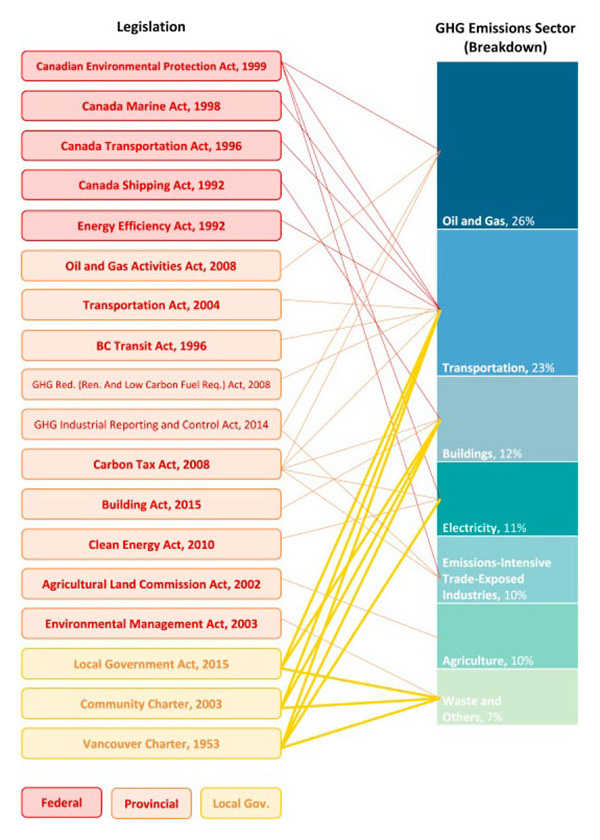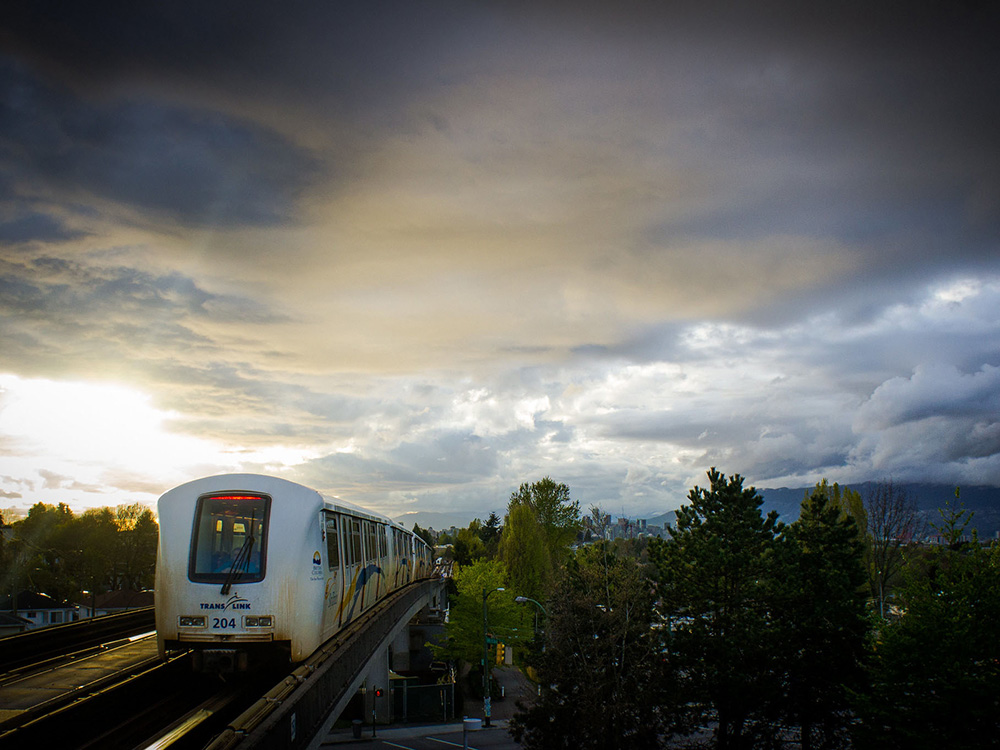Ask most people about an emergency response to climate change and a green transition — two issues highlighted when we asked Tyee readers to guide our election coverage — and they’ll likely think the energy industry and its workers.
But how will city life change if we’re serious about the transition? And what are the parties promising to do to make it happen?
In Vancouver, 96 per cent of the city’s carbon pollution comes from buildings and transportation. The municipality has ambitious plans to be a cleaner city, including an 80-per-cent reduction in carbon emissions from 2007 levels by 2050.
If all goes according to plan, this is what 2030 will look like.
More people will be biking and taking public transit than ever, but this is ultimately a walkable city. Densification will mean that shops, services, jobs, parks and schools will be a quick stroll away.
Road congestion will have gone down by 20 per cent since 2019, thanks to new rapid transit like the Broadway subway, as well as the gradual elimination of gas-guzzling cars in favour of electrics.
If you’re on the road and low on battery, have no fear — you can expect to find a fast-charging station for your electric vehicle every 10 minutes in the city. But if your car is running on gasoline in 2030, expect inconvenience. Electric vehicles have priority when it comes to city parking.
Every building that goes up in Vancouver will be zero emission, as required by bylaws. Step inside one, and you’ll notice you don’t feel a draft — they’re well insulated.
These changes mean the average household will be paying almost $600 less in annual home and transportation energy costs than today.
Carbon pollution will be down to 1.43 million tonnes, half of what it was in 2007. Renewable sources will make up more than half of the city’s energy, with Vancouver on its way to a goal of 100-per-cent renewable energy by 2050.
The problem is that cities, no matter how ambitious, can’t accomplish this transformation on their own.
Rose Murphy, a post-doctoral expert on sustainability at Simon Fraser University, said cities have taken up the fight against climate change “after a long period of inaction at higher levels of government in Canada.”
“You can’t really fault them for stepping into that vacuum,” she said. “Our concern was that this would effectively let senior governments off the hook.”
Murphy co-authored an article this year in the academic journal Energy Policy on the feasibility of Vancouver’s plan to meet its 2050 goal for emissions and use only renewable energy.
Her team found that Vancouver “does not even come close” to meeting its 2050 targets through municipal policies. Even more aggressive city policies wouldn’t be enough to close the gap.
While cities have authority over things like land use and transportation planning, the federal government controls high-impact actions such as carbon pricing and regulating fuel and vehicles types.
“It’s a regulatory challenge,” said Murphy. “Cities have the carrots, not the sticks.”
For example, a city might be able to build charging stations to encourage the use of electric vehicles, but “top-down” actions from the federal government like banning the sale of vehicles with internal combustion engines will force faster change goals, Murphy said.

While in power, the Trudeau government — aside from the big smear on its environmental record that was the nationalization of the Kinder Morgan pipeline — levied a federal carbon tax on provinces that don’t have carbon pricing, began a phased closure of coal plants with a planned elimination of coal-powered electricity by 2030, and proposed a Clean Fuel Standard that will regulate all fossil fuels.
With the upcoming election, what are the federal parties promising to help communities get carbon free?
The Conservatives’ platform has been singled out by experts as the weakest on a cleaner future: it’s vague, it plans to scrap Canada’s current carbon pricing system, and it’s the only federal party without an emissions target. What the Conservatives do offer is the return of Harper’s tax credit for public transit users, and priority funding for infrastructure that will help with automobile gridlock.
This was not well received in Vancouver. When Conservative Leader Andrew Scheer promised a Massey tunnel replacement, a car-centric project, during a 100,000-strong climate protest in the city, journalists who attended the announcement called it tone deaf.
The other parties all offer different roadmaps towards net-zero futures.
If re-elected, Justin Trudeau’s Liberals have pledged a goal of zero emissions nationally by 2050 and to meet the Paris Agreement target (a 30-per-cent reduction from 2005 levels by 2030) along the way. For local communities, the Liberals promise more public transit spending at $3 billion a year, interest-free loans of up to $40,000 for homeowners doing energy efficient retrofits, and investments to push the wider use of zero-emissions vehicles.
The NDP has pledged to meet the Paris Agreement target as well. The party has also promised to work towards free public transit, electrify municipal vehicles and public transit by 2030, invest in the research and development of zero-emissions vehicles, and offer tax breaks for purchasing them.
“I want a future where... you will go to school or go to work on free and accessible public transit or in your own zero-emission car, all built in Canada to build our economy,” leader Jagmeet Singh said in Montreal during his campaign.
The NDP also set a target of retrofitting all homes in Canada for greater energy efficiency by 2050 through low-interest loans.
The Greens are more ambitious than the other parties with their emissions target, promising a 60-per-cent reduction from 2005 levels by 2030. In addition, the Greens want to develop a national transportation strategy with a goal of zero-emission public ground transportation by 2040.
Leader Elizabeth May said during the campaign in Calgary that “there isn’t any place in Canada where we now have adequate transit.”
The Greens plan to ban the sale of internal combustion engine passenger vehicles by 2030 and, like other parties, also pledge to incentivize zero-emission vehicles.
Murphy at SFU has a few words of caution for cities as they chase their green goals with the aid of a federal partner.
Vancouver has the advantage of a robust public transit network, but urban centres without one — and without the population density to support one — will have to rely more on switching to zero-emissions vehicles.
There is also the challenge that energy analysts call the rebound effect. If congestion decreases, people might want to hop into a private vehicle again.
And as fewer people purchase gas for their vehicles, that’s less fuel tax for senior governments to spend.
In the meantime, Vancouver business leaders have been modelling the green transition to their peers, from film set designers opting for sustainable materials to fleet managers opting for zero-emissions vehicles, according to the Vancouver Economic Commission, a city agency.
Their 2018 report found that there are now 25,000 green jobs — jobs that help restore or preserve the environment — in the city, a 35-per-cent increase since 2010. The fastest growing sectors are local food and green building.
“Clearly, going green has not slowed down our economy and it certainly has not made Vancouver and B.C. less attractive for investment,” the agency’s staff told The Tyee by email via its communications specialist Ingrid Valou. (CEO Catherine Warren was unavailable for an interview.)
The agency hopes for more spending from the federal government on public transit and research and development of sustainable technologies.
SFU’s Murphy said cities need the federal support.
“Given the powers that municipalities have,” she said, “there are real difficulties for them to achieve their goals.”
The federal election is Oct. 21. ![]()

















Tyee Commenting Guidelines
Comments that violate guidelines risk being deleted, and violations may result in a temporary or permanent user ban. Maintain the spirit of good conversation to stay in the discussion.
*Please note The Tyee is not a forum for spreading misinformation about COVID-19, denying its existence or minimizing its risk to public health.
Do:
Do not: